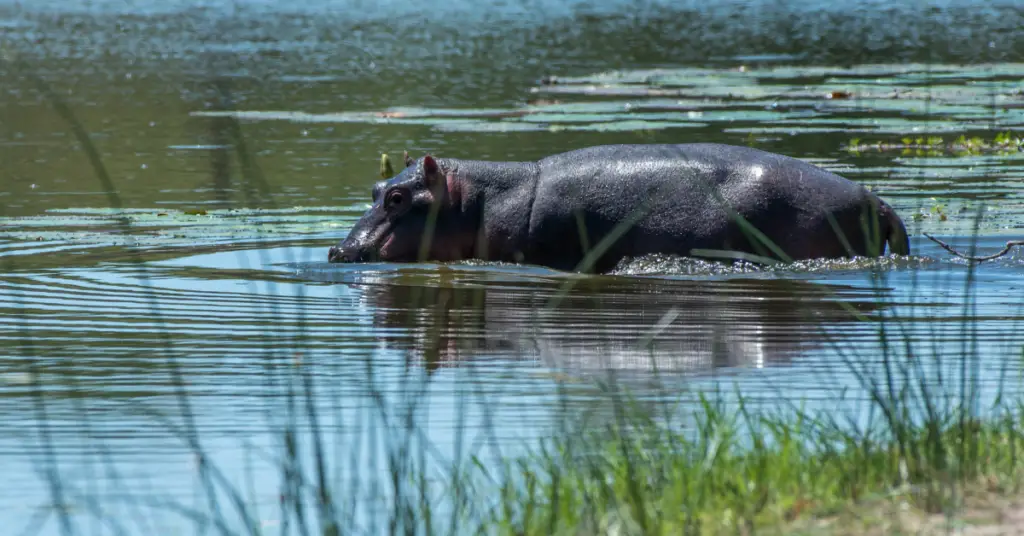Common Hippos are endemic to Africa, ranging widely over most of sub-Saharan Africa, from Senegal and Gambia in the west to Sudan, Ethiopia, and Somalia in the east, and south to KwaZulu–Natal in NE. South Africa, the Okavango Delta in Botswana, and the Kunene R. in Namibia. They are restricted to appropriate areas, e.g.meadows with rivers, lakes, and swamps; absent from rainforest except for rivers with adjacent grassy areas.
In the past, Common Hippos occurred in the Nile R. to the Nile Delta, and until 1700 they were still present in two disjoint areas of the Nile Delta and in the upper Nile; the last definite records from Egypt come from the early 1800s, their disappearance principally caused by hunting.
Common Hipposalso occurred in the Sahara, and in South Africa, right to the Cape where they have been wiped out in historic times. In the recent past, they have been locally eradicated or severely reduced. For example, the populations of the crater lakes around Dongobesh, Basodesh, and Hanang in Tanganyika have completely vanished over the last 50 years.
Apparently, previously present on Mafia I., and possible that they still occasionally occur; excluded from the fauna of Zanzibar and Pemba.
Present Distribution of Hippopotamus
Distribution in Africa, where it is currently confined to Alto lowland forests, Guinea to Liberia, Côte d’Ivoire, Guinea, and Sierra Leone. An isolated subspecies, C. l. heslopi, which previously occurred about 1800 km east of the Niger Delta east of Cross R.region of the province of Calabar, and the marshes of Niger R .in Kwale, and Aboada, Asaba, Onitsha, the subspecies has not been recorded for over half a century and its continued presence seems unlikely.
It is suggested that the only remaining possibility was in the Upper Orashi Forest Reserve. Their current distribution is more fragmented than in the past, largely due to significant forest loss in the Upper Guinea lowland rainforests.
The core of the species’ range is centered in Liberia, which has the most extensive tracts of intact lowland forest in the region.
Pygmy hippos are also found in neighboring Sierra Leone, south-eastern Guinea (including Ziama and Diécké), and south-western Côted’Ivoire, in Haut Cavally R., south of the Mt Nimba massif. In Liberia, their distribution seems to be divided between the large remaining forest blocks in the southeast (centered on SapoN. P.) and in the northwest of the country.
The extreme west of the species seems to have been authentically recorded in the past near Forécariah, Kindia, Guinea, but there is no present day records further west from northwestern Sierra Leone.
Pygmy hippos are noted in Loma Mts, north of the country. With the exception of northwestern Sierra Leone, Côte d’Ivoire Bandama R. as far north as the confluence of the NziR., no other locations have been noted where the pygmy and common hippos are currently overlapping.
Historically, however, it is likely that these two species had small range overlaps; for example, in southwestern and 100 years ago in the Junk River region of Liberia, Heslop (1945)reported seeing pygmy hippo tracks within 20 feet of those of a common hippo in the Niger Delta region.
Habitat of Common Hippos
Hippos require water for thermoregulation and skin protection and are therefore never far from a water source, be it a river, lake, or orchard. a swamp. Common hippos feed mainly on grasses, so their range is restricted to grasslands and bushes within reach of water (even where they occur in saline water, grazing and fresh water are essential).
They can use established ponds for many years as long as enough food is available and not to be disturbed; seasonal flooding can temporarily displace them from their established resting places.
Habitat of Pigmy Hippopotamus
Lowland primary and secondary evergreen forests, sometimes penetrating savanna regions along gallery forests. It prefers isolated areas with low anthropogenic disturbance; the river and marshy areas are much more frequented than the mountain forest sites. Habitats must provide adequate cover for resting, calving, and lactation of calves.
Pygmy hippos often follow the streams and ravines of dry-season forests on their journeys and do not hesitate to cross rivers and streams, generally fleeing water to take refuge in the forest in case of an encounter. Dug and eroded levees of forest streams and rivers are not commonly used as opportunistic retreats, a habit that is exploited by hunters.
The seasonal climate within the species’ range is characterized by a major dry season variably between Nov. and Mar., with significant rainfall during the rest of the year.

Erzsebet Frey (Eli Frey) is an ecologist and online entrepreneur with a Master of Science in Ecology from the University of Belgrade. Originally from Serbia, she has lived in Sri Lanka since 2017. Eli has worked internationally in countries like Oman, Brazil, Germany, and Sri Lanka. In 2018, she expanded into SEO and blogging, completing courses from UC Davis and Edinburgh. Eli has founded multiple websites focused on biology, ecology, environmental science, sustainable and simple living, and outdoor activities. She enjoys creating nature and simple living videos on YouTube and participates in speleology, diving, and hiking.

